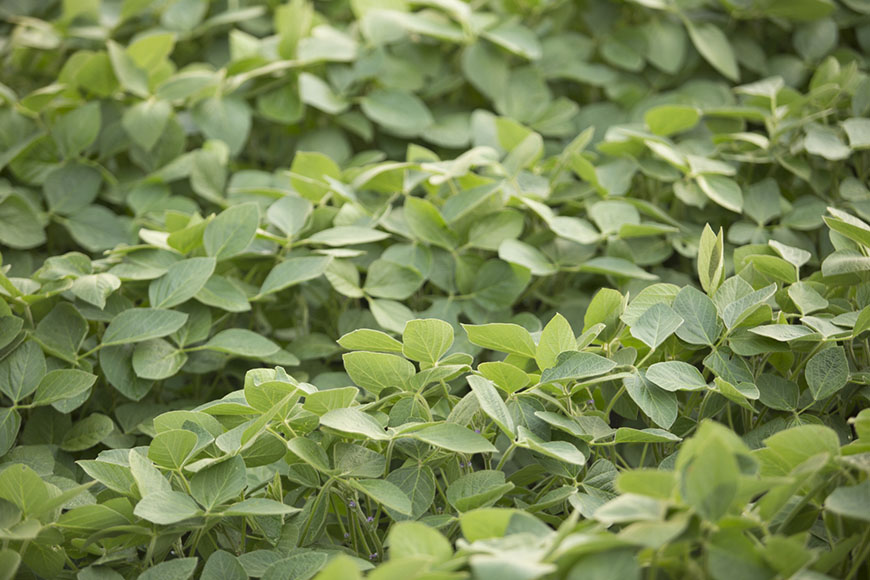With Great Dicamba Power Comes Great Responsibility

Costly lessons were learned last year when off-label dicamba formulations were applied to dicamba-tolerant soybeans. In Missouri alone, 45,000 acres of sensitive soybeans were officially reported as damaged due to off-target dicamba movement, with another 100,000 acres of soybean crops estimated to be unofficially damaged, according to Kevin Bradley at the University of Missouri.1 Along with soybeans, damage extended to a variety of fresh market crops, homeowners’ gardens, trees and more.
The most important takeaway was that crops outside of the new dicamba-tolerant system are inherently sensitive to extremely low concentrations of dicamba. While assessing the damage caused in 2016, it’s important to learn from these mistakes in order to successfully incorporate the new dicamba-tolerant soybean technology into our weed-control arsenals.
Respect the Herbicide
The most obvious cause of last season’s problem was the use of off-label dicamba treatments. While new dicamba-tolerant seed was available in 2016, dicamba herbicides for use with this technology were not yet labeled for use. With a growing number of tough, resistant weeds threatening soybean yields, some operations jumped the gun by making off-label applications with older dicamba formulations.
Along with applying off-label dicamba formulations, several other factors likely played a role in setting the stage for damage to neighboring crops, including the use of the wrong-size spray tips, which allowed fine spray droplets to easily drift off target. Other causes may have been application timing errors, such as spraying when conditions were conducive to temperature inversions. Another culprit could have been the use of ammonium sulfate (AMS) as a water conditioner in the tank mix, which would have increased the potential for volatility.
Follow Specific Guidelines
During spray clinics conducted by WinField United agronomists this winter, we provided some recommended practices for use with dicamba-tolerant soybeans to help farmers successfully add this new weed-management tool to their production system. These guidelines include the following:
1. Dr. Kevin Bradley. “A Season to Remember: Our Experiences with Off-Target Movement of Dicamba in 2016.” Available at: http://weedscience.missouri.edu/2017%20Preparing%20for%20Xtend.pdf. Accessed June 12, 2017.
The most important takeaway was that crops outside of the new dicamba-tolerant system are inherently sensitive to extremely low concentrations of dicamba. While assessing the damage caused in 2016, it’s important to learn from these mistakes in order to successfully incorporate the new dicamba-tolerant soybean technology into our weed-control arsenals.
Respect the Herbicide
The most obvious cause of last season’s problem was the use of off-label dicamba treatments. While new dicamba-tolerant seed was available in 2016, dicamba herbicides for use with this technology were not yet labeled for use. With a growing number of tough, resistant weeds threatening soybean yields, some operations jumped the gun by making off-label applications with older dicamba formulations.
Along with applying off-label dicamba formulations, several other factors likely played a role in setting the stage for damage to neighboring crops, including the use of the wrong-size spray tips, which allowed fine spray droplets to easily drift off target. Other causes may have been application timing errors, such as spraying when conditions were conducive to temperature inversions. Another culprit could have been the use of ammonium sulfate (AMS) as a water conditioner in the tank mix, which would have increased the potential for volatility.
Follow Specific Guidelines
During spray clinics conducted by WinField United agronomists this winter, we provided some recommended practices for use with dicamba-tolerant soybeans to help farmers successfully add this new weed-management tool to their production system. These guidelines include the following:
- Only use newly registered dicamba formulations labeled for use with dicamba-tolerant soybeans. Older dicamba formulations are more volatile, making off-target movement more likely.
- Read and understand the new dicamba product labels. These labels are the law and closely define how the product must be used.
- Consider the required combinations of products listed on the labels. XtendiMax® With VaporGrip® Technology for example, requires an approved drift reduction agent like AG16098 from WinField United, which reduces driftable fines, in the mixture when certain other herbicides and adjuvants are used.
- Avoid adding AMS to the spray tank.
- Use the correct nozzle type listed on the label to achieve coarse droplets. Also use the labeled pressure rate and don’t exceed the pressure limit.
- Keep boom heights at no higher than 24 inches above the target. A lower boom height helps spray droplets stay out of the wind and remain on target.
- Slow down. Maintaining the right ground speed helps control boom height and keeps spray pressures in check.
- Understand your surroundings. Wait until the wind changes direction to spray if sensitive crops are downwind. Or if a highly susceptible crop is nearby, do not spray dicamba products. Use other labeled herbicides to treat your field.
- Maintain buffer zones when sensitive areas are downwind. Follow buffer recommendations listed on the label.
1. Dr. Kevin Bradley. “A Season to Remember: Our Experiences with Off-Target Movement of Dicamba in 2016.” Available at: http://weedscience.missouri.edu/2017%20Preparing%20for%20Xtend.pdf. Accessed June 12, 2017.

